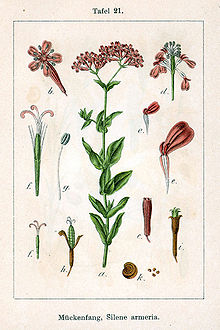Carnation catchfly
| Carnation catchfly | ||||||||||||
|---|---|---|---|---|---|---|---|---|---|---|---|---|

Clove catchweed ( Atocion armeria ) |
||||||||||||
| Systematics | ||||||||||||
|
||||||||||||
| Scientific name | ||||||||||||
| Atocion armeria | ||||||||||||
| ( L. ) Raf. |
The carnation catchwort or garden catchweed ( Atocion armeria , Syn .: Silene armeria L. ) is a species of the genus Atocion within the carnation family (Caryophyllaceae). It is used as an ornamental plant in parks and gardens .
description
Vegetative characteristics
The clove catchment is an annual herbaceous plant that is perennial in warmer areas and reaches heights of 20 to 70 centimeters. All above-ground parts of the plant are bare and more or less blue-green. The stems are erect and not very branched apart from the inflorescence.
Generative characteristics
The 2 to 5 centimeters long basal leaves are eilanzettlich, but they wither before the flowering period. The 1 to 6 centimeters long, opposite stem leaves are ovate, elliptical to broadly ovate. They are sessile and therefore sitting on the stem to encompass the stem. There are sticky rings under the knots of the stem.
In the terminal and trugdoldigen zymous inflorescences , the flowers stand upright and dense. The bracts are eilanzettlich to needle-shaped. The short flower stalks are 1 to 5 millimeters long.
The hermaphrodite flowers are radially symmetrical and five-fold. They have ten-nerved, more or less skin-like, purple-colored, about 1.5 centimeters long, fused sepals . The tubular calyx, with small tips, is club-shaped. The purple, rarely white, obovate and nailed petals are unlobed and slightly edged at the tip. The 2 to 3 millimeters long, priemlichen gullet scales are striking.
Small capsule fruits ( false fruit ) are formed in the constant calyx on a short carpophor . The small, finely carved seeds are kidney-shaped.
The number of chromosomes is 2n = 24.
Occurrence
Atocion armeria is native to the Mediterranean , Central and Eastern Europe and Turkey . It is a neophyte in North and South America, Australia, New Zealand, Japan, Korea, the Azores and Madeira .
Carnation catchwort grows in Central Europe on dry grassland, dry fallow land and on moderately moist shrubbery edges. It is also cultivated as a garden plant because of its dense purple inflorescences. Many of the occurrences in Central Europe can be traced back to garden plants. In many parts of North America and parts of Asia is considered Atocion armeria as naturalized. It grows there especially in "disturbed" places such as roadsides and roadsides.
Taxonomy
The first publication took place in 1753 under the name ( Basionym ) Silene armeria by Carl von Linné in Species Plantarum , page 420. The new combination to Atocion armeria (L.) Raf. was published in 1840 by Constantine S. Rafinesque-Schmaltz in Autikon Botanikon , page 29. Synonyms for Atocion armeria (L.) Raf. are for example: Silene glauca Salisb. nom. illegal, Silene lituanica Zapał.
literature
- Henning Haeupler , Thomas Muer: picture atlas of the fern and flowering plants of Germany (= the fern and flowering plants of Germany. Volume 2). Published by the Federal Agency for Nature Conservation. Ulmer, Stuttgart 2000, ISBN 3-8001-3364-4 .
- Werner Rothmaler: Excursion flora for the areas of the GDR and the FRG. Volume 2: Vascular Plants , 14th Edition. People and knowledge, Berlin 1988, ISBN 3-060-12539-2 .
Individual evidence
- ↑ a b Božo Frajman, Mikael Thollesson, Bengt Oxelman: Taxonomic revision of Atocion and Viscaria (Sileneae, Caryophyllaceae). In: Botanical Journal of the Linnean Society , Volume 173, Issue 2, 2013, p. 202. DOI: 10.1111 / boj.12090 online.
- ^ Erich Oberdorfer : Plant-sociological excursion flora for Germany and neighboring areas. 8th edition. Verlag Eugen Ulmer, Stuttgart 2001, ISBN 3-8001-3131-5 , p. 362.
- ^ A b Silene armeria in the Germplasm Resources Information Network (GRIN), USDA , ARS , National Genetic Resources Program. National Germplasm Resources Laboratory, Beltsville, Maryland. Retrieved August 4, 2020.
- ↑ Karol Marhold, 2011: Caryophyllaceae. : Datasheet Silene armeria In: Euro + Med Plantbase - the information resource for Euro-Mediterranean plant diversity .
Web links
- Silene armeria L., clove catchweed. In: FloraWeb.de.
- Carnation catchfly . In: BiolFlor, the database of biological-ecological characteristics of the flora of Germany.
- Silene armeria L. In: Info Flora , the national data and information center for Swiss flora . Retrieved October 8, 2015.
- Thomas Meyer: Data sheet with identification key and photos at Flora-de: Flora von Deutschland (old name of the website: Flowers in Swabia ).
- Flora of North America - Silene armeria .
- Datasheet Atocion armeria (Silene armeria) - Garten-Felsenleimkraut / (Garten-Kleimkraut) / Morgenröschen with photos at Botanik im Bild / Flora von Österreich , November 28, 2005.

